The Barley & Harwood Company's Indiana Truck
Indiana Truck

The history of Indiana Truck Corporation in Marion, Indiana.
Above: Indiana Truck Logo
The Life of Indiana Truck Corporation
By Taposh Rudra
The early twentieth century was a time of great development in the automotive industry. Across America and around the world, assembly lines were producing vehicles that were changing the lives of everyone from ordinary middle-class workers to the owners of businesses. One company that found relative prosperity during this time was the Indiana Truck Corporation, founded and based in Marion, Indiana. Indiana Truck began as a bedstead manufacturing venture, then after experimental truck production, began producing trucks. From 1910 to 1933, Indiana Trucks was a truck manufacturer in Marion for both business and personal purposes affecting customers all across the nation. Production was boosted by the need for military vehicles in World War I, and the company boomed in the 1920s along with the nation's economy and the growth of highways, before being acquired by Brockway in 1928 and ending production in Marion in 1933. Like many small automotive companies of the time, Indiana Trucks experienced a quick rise and fall in prosperity at the start of the twentieth century.
What later became Indiana Truck Corp. started out in manufacturing bedsteads but quickly turned to trucks. It was started in 1898, when Marion manufacturers George C. Harwood and Charles G. Barley formed a partnership. At that point, the company was named the Marion Iron and Brass Bed Company. In the first decade of the twentieth century, the automotive industry was beginning to boom, especially in the Midwest. Historian Mark Sullivan said in his book Our Times that during this time, "in nearly every village and town in America, especially in the Midwest, the local mechanical genius devoted his whole being to this new device (the automobile)"(97). In 1895, approximately 300 motor vehicles were in operation in the United States. Ten years later, the number was close to 78,000. The company became involved with experimental truck production.
The first truck made entirely by the company was released in 1910, after several months were spent building the truck and testing it. The truck was sold to O. Gordon, a furniture dealer in Gas City, Indiana. Gordon later sold his truck to Gas City resident Charles Stewart. The new owner praised his truck in a 1923 book of testimonials from Indiana Truck owners, published by the company. Stewart said: "Almost six years ago I bought my old Indiana Truck from O. Gordon, who had used it for a number of years. I am using this old truck every day, doing local and long distance hauling. This truck paid for itself the first three months of service. It is very cheap to run and I have absolutely no engine trouble. It starts easily in the morning and keeps running smoothly all day. I consider this old truck equal to any job. This old Indiana certainly is a good one, even though it is thirteen years old." At the time the book was published, the original truck had racked up 140,000 miles. The introduction to the book clarified that it is "equivalent to five trips around the world".
In 1911, the company changed its name to the Harwood-Barley Manufacturing Company and devoted itself to the production of trucks along with the continuing manufacturing of bedsteads and bedsprings. In 1913, to convince potential customers and salesmen of the quality of the Indiana Trucks, the company published a list titled: "39 Reasons Why You Should Sell Indiana Trucks." At the time, automotive companies were still trying to prove that cars and trucks were wiser choices than horses and wagons, as displayed by reason number three on the list: "3. Because Indiana Motor Trucks are more dependable than horses and sure in the extreme heat of summer or in the snow and ice of winter". Reason number 17 said: "17. Because there have been only two advances made in the delivery of merchandise, namely, from the time of oxen, then to the horse, now to the Indiana Trucks, while other systems of manufacturing, sales, and what not have entirely changed". A booklet published by the company indicated another sign of the changing times, which listed the dangers, obvious to us today, of speeding in a motor vehicle: "On an even stretch of pavement the temptation is strong to 'get there.' TIME is a less important factor than SAFETY, to yourself, pedestrians, and the truck". By 1913 the company was doing business across the country, as more and more consumers were turning to trucks.
Indiana Trucks increased production and expanded business from 1914 to 1926. One reason was the World War in the late 1910s. The United States became involved in World War I in 1917 after German attacks on the US ships, City of Memphis, Illinois, and Vigilancia. The involvement in the war brought about a necessity for vehicles to help. Fifteen truck manufacturers helped with the production of the class "B" Liberty trucks. One of these manufacturers was Harwood-Barley, as they produced 475 Liberty trucks during the period of 1917-1918. The "Veteran Indianas" catalog also told stories of other satisfied owners of Indiana Trucks. One owner said that his 13 year-old Indiana "runs like new . . . I moved a barn with it. The barn was 30x40 ft. old fashion frame. I moved it about 60 rods. I pulled it with this old truck".
In 1918, Indiana Trucks consisted of four different models advertised in it's catalog. One was the Model "T" 1-ton Worm Drive. The Indiana Truck catalog described it as "built rugged". It had a "heavy channel steel frame that will carry the load over the roughest roads with sureness. Motor operates silently and economically under severe conditions. The quality of this Indiana Truck safeguards your investment". Another truck produced in 1918 was the Model "D" 2-ton Worm Drive, what the catalog called "America's Greatest Truck Value". The company now had trucks for many different purposes, including the Model "L" 5-ton Worm Drive, a "Big Truck to Carry Big Loads". In 1915, the Harwood-Barley Manufacturing Company changed its name to Indiana Truck Company, reflecting its main concentration of business. In 1917 it was reorganized as Indiana Truck Corporation. Indiana Truck Corporation grew to a national level, and in 1925 owned fourteen depots across the country, many in the South. They included outlets in Jacksonville, Tampa, Miami, West Palm Beach, Atlanta, Dallas, Chicago, St. Louis, Kansas City, Louisville, Pittsburgh, Long Island, Cambridge, and San Francisco. In 1925, the company claimed to be "one of the most successful manufacturers of high grade Motor Trucks in the country".
The company thrived through the end of the 1920s, but its time in Marion was limited after being acquired. It was the end of an era of independence for the Indiana Truck Corporation, as Brockway controlled it from 1928 to 1932. The company kept the name of Indiana Truck Corporation, however, and continued to operate out of the Marion factory. The 1927 line of Indiana Trucks contained sixteen different models. One of the larger trucks built was the Indiana Model 115-A Road Builder. The large truck could go 25 miles per hour ("Full line 1927").
The end of the 1920s was one of the most productive times in the history of Indiana Trucks at the Marion location. A booklet published by the company in 1929 contained a list of companies, organizations, and governments who owned multiple Indiana Trucks. It also contained pictures of many of these fleets. In the back of the booklet was a page advertising the dependability of Indiana Trucks. It claimed, "20 years of successful production and service . . . Performance counts! A specialized motor truck composed of specialized units-built to fit your particular hauling problem. Balanced construction to meet the exacting demands of modern transportation. Thousands of Indiana Trucks are substantiating our claims by actual performance in every state and many foreign countries." In 1928, the company's catalog listed fourteen different trucks, including three of the Road Builder models: the Indiana 111-X, 115-A, and 127-A. All three of these models, just like the three Road Builder models from 1927, included built-in dumping bodies on the back of the truck. The dumping body is the cargo hold in the back of a truck that can be tilted to dump out or load contents more easily. The catalog described one of these devices, saying "this model 111-X Road Builder chassis is also furnished with 41 cubic foot dump body and hydraulic underbody hoist . . . Body width 60" front, 64" rear, length 66", height 17 3/8". Top of body from ground when empty 57". 52° dumping angle".
Eventually, the company became a subsidiary of White in 1932, and the name of the company was changed to Indiana Motors Corporation. On December 12, 1932, White Corporation announced they would move production of Indiana Trucks from Marion to Cleveland, Ohio. White continued to make trucks bearing the Indiana name until 1939.
During its years in Marion, the Indiana Truck company found relative prosperity and success in the trucking business, spreading it's business throughout the United States. Its success in the early part of the twentieth century in Marion was short-lived due to its transfer out of the area, as the White corporation only used it as a name to attract customers for several years. However, as shown by the variety and dependability of the different models, the Indiana Truck Corporation was a successful company that expanded to many areas of the trucking business during it's years in Marion, Indiana.
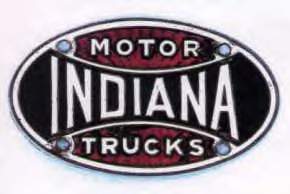
Indiana Truck Corporation
Indiana Truck Corporation made it's first full truck in 1910.
These are a few of the many models of Indiana Trucks that were created during the company's existence in Marion.
1910
1910
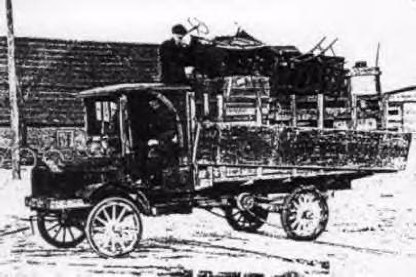
The first Indiana Truck, No. 1001, which was sold to
O. Gordon of Gas City, and later resold to Charles Stewart.
1918

The Model "T" 1-ton Worm Drive.
Indiana claimed that the "motor operates silently and
economically under sever conditions."
Model "T" specifications
From the 1918 Indiana Truck Full Line Catalog.
Capacity: 1 ton.
Motor: 3 1/2" x 5 1/4", four cylinder, four cycle, cast en bloc, three point suspension, located under hood in front.
Motor cooled by centrifugal pump and fan. Lubrication constant level automatic splash system. Enclosed valve action.
Motor speed controlled by governer.
Wheel base: 135".
Tires: Front, 34" by 3 1/2"; rear, 34 by 4". Solid S.A.E. Standard Goodyear, Goodrich, or Firestone.
Transmission: Selective type, three speeds forward and one reverse.
Gear ratio: 7 to 1 on high gear
1918

The Model "D" 2-ton Worm Drive.
It was deemed "America's Greatest Truck Value" by Indiana Truck.
Model "D" specifications
From the 1918 Indiana Truck Full Line Catalog.
Capacity: 2 tons.
Motor: 4 cylinders, cast in pairs, 4 1/8 x 5 1/2". Motor located under hood. Motor speed controlled by governer.
Wheel base: 150".
Tires: Solid rubber, S.A.E. Standard Goodyear, Goodrich, or Firestone. Front, 36"x4"; rear, 36"x7" single.
Wheels: Artillery type. S.A.E. Standard. Front wheels have fourteen 2" spokes. Rear wheels have fourteen 2 1/2" spokes.
Tread: 58".
Frame: Class A structural channel, 6" section, 8 pounds per foot, reinforced with guesset plates.
1927
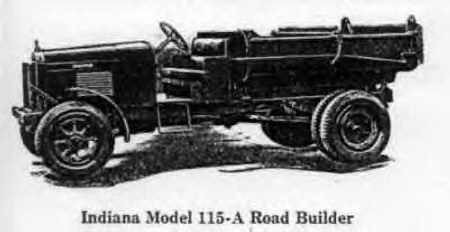
The Model 115-A Road Builder.
A versatile truck with a dumping body at the back.
Model 115-A specifications
From the 1927 Indiana Truck Full Line Catalog.
Capacity: Two 7-bag batches. Weight complete with 60 cubic feet body and hoist 7000 pounds.
Gear Ratio: 8 to 1. Speed 25 miles per hour. Engine: 4 cylinders. Radiator: Fin and tube type radiator with removable core in cast iron shell. Top casting polished aluminum.
Clutch: Dry plate type. Raybestos against steel. All parts enclosed. Easily adjusted.
Transmission: Four speed selective type mounted in unit with motor. Gears and shafts special treated alloy steel mounted on taper roller bearings. Reduction low gear 5.35 to 1. Size main shaft 1 1/2". Gears are 3/4" wide.
Frame: Pressed steel construction- 6 1/8" deep, 1/4" thick, 3 1/4" flange. All castings and cross members are hot riveted to frame.
1927

The Model 127 3-ton Cargo Chassis.
Model 127 specifications
From the 1927 Indiana Truck Full Line Catalog.
Capacity: 3 tons; body allowance 1500 lbs.; total maximum load 7500 lbs; chassis weight 6800 lbs.
Wheelbase: Standard 162 1/2"; long 186 1/2".
Tires: Front 36"x5"; rear 36"x10".
Gear ratio: Standard 8 to 1; speed 20 miles per hour.
Engine: 4 cylinders, 4 1/2", 5 3/4" stroke. L-head, cylinders, and crankcase cast in block. Oil filtrator prevents foreign substance from reaching bearings.
1928
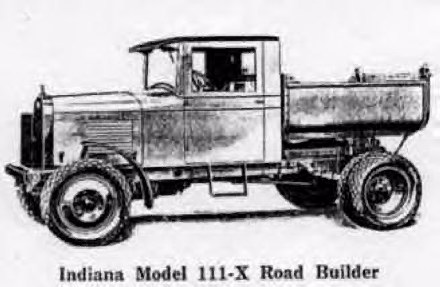
The Model 111-X Road Builder.
Model 111-X specifications
From the 1928 Indiana Truck Full Line Catalog.
Capacity: 1 1/2 cubic yards; weight complete with body 4635 lbs.
Wheelbase: 120 inches.
Tires: Front 32x6" pneumatic cord; rear 32x6" dual pneumatic cord.
Gear ratio: 6.28 to 1; Speed 30 miles per hour.
Engine: 4 cylinders, 4" bore, 5" stroke; L-head, cylinders and crankcase cast in block. Detachable cylinder head. Oil filtrator intregal with motor.
Thank you Marion Public Library, Marion, Indiana & also Taposh Rudra for writing this report.
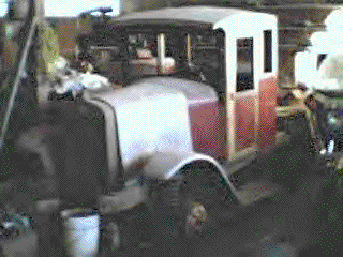
This is a 1925 model 15 Indiana built by Barley & Harwood
The owner is in search of a frame for this beauty
E-mail Bob McDaniel: [email protected]